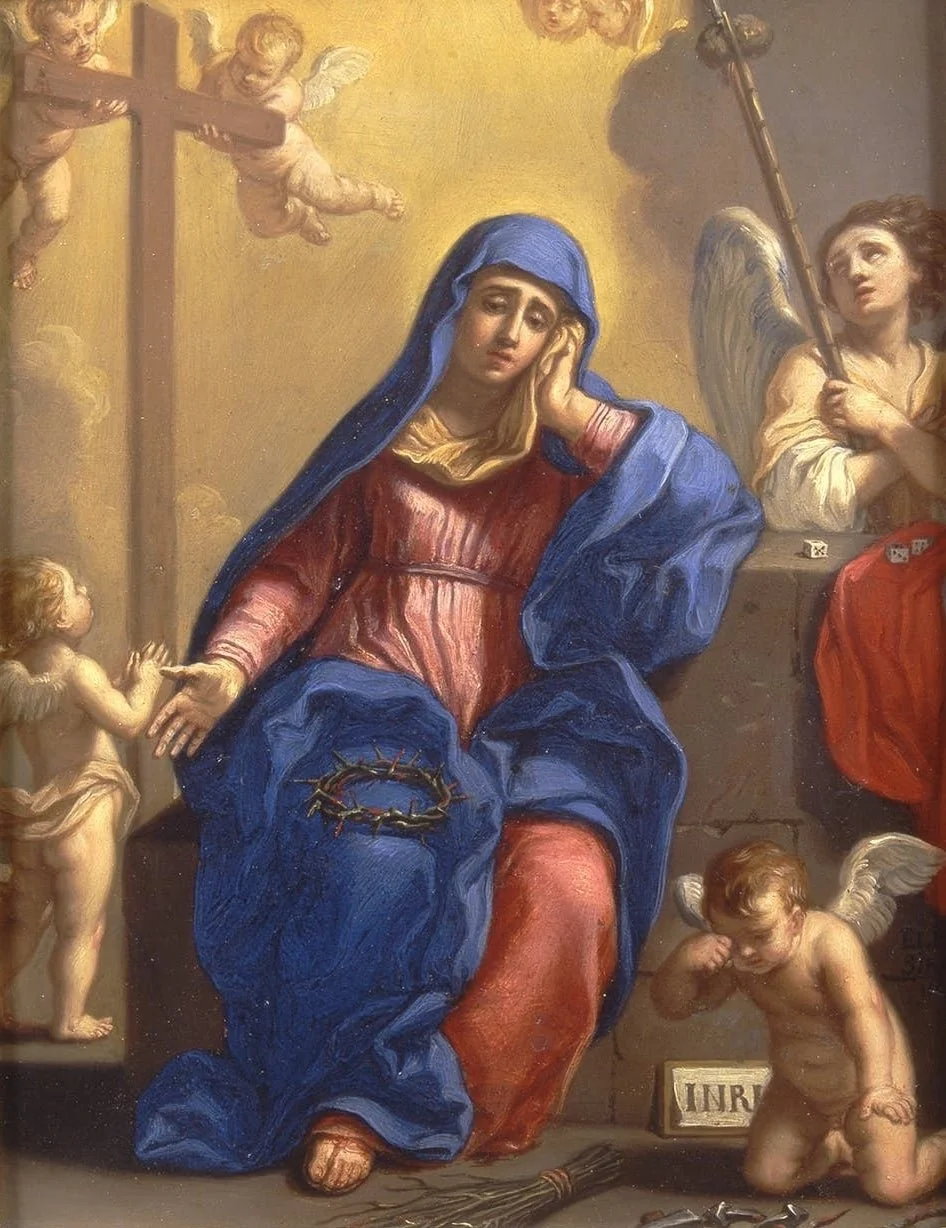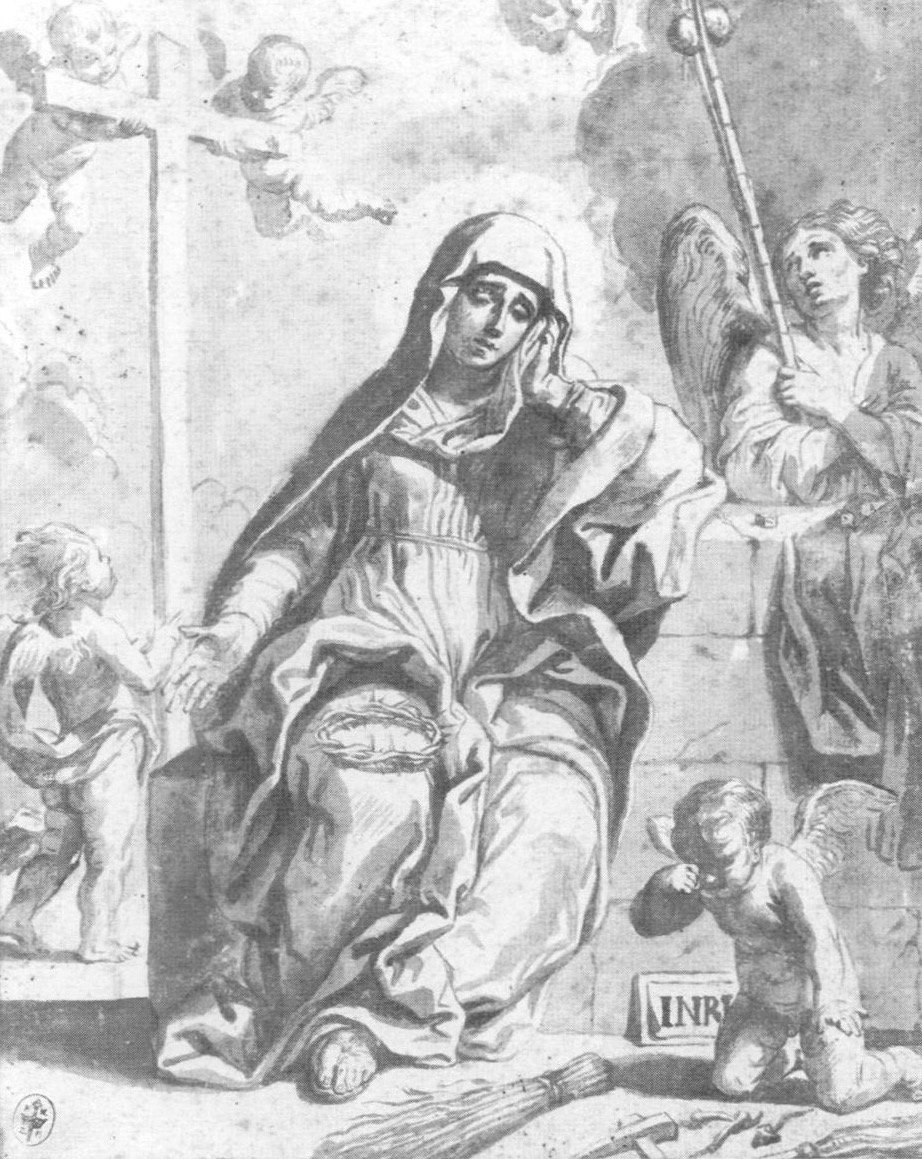ELISABETTA SIRANI
(Bologna, 1638 – 1665)
Madonna of Sorrows with Symbols of the Passion
Signed on the plate, lower right: Elisabta Sirani .F. d.d. 1657
Etching
Untrimmed with distinctive platemark
15 ⅝ x 11 ½ inches (39.7 x 29.3 cm)
Provenance:
Private Collection, Italy, until 2024.
Literature:
Carlo Cesare Malvasia, “Nota delle Pitture fatte da me Elisabetta Sirani,” in Felsina Pittrice: Vite de’ Pittori Bolognesi, Bologna, 1678 (ed. Giampietro Zanotti, 1841), vol. 2, p. 394.
Adam von Bartsch, Catalogue raisonné des estampes gravées a l’eau-forte, par Guido Reni, et de celles de ses disciples Simon Cantarini, dit le Pesarese, Jean-André et Elisabeth Sirani, et Laurent Loli, Vienna, 1795, pp. 83-84.
Adelina Modesti, “Alcune riflessioni sulle opere grafiche della pittrice Elisabetta Sirani nelle raccolte dell’Archiginnasio,” L’Archiginnasio, vol. 96 (2001), pp. 162-164, fig. 8.
Adelina Modesti, Elisabetta Sirani: Una virtuosa del Seicento bolognese, Bologna, 2004, pp. 89, fig. 47.
Adelina Modesti, Elisabetta Sirani ‘Virtuosa’: Women’s Cultural Production in Early Modern Bologna, Turnhout, 2014, pp. 229-230, fig. 131.
Irene Graziani, in Elisabetta Sirani: “Pittrice Eroina,” 1638–1665, ed. Jadranka Bentini and Vera Fortunati, exh. cat., Bologna, 2004, pp. 250, 271.
Babette Bohn, Women Artists, Their Patrons, and Their Publics in Early Modern Bologna, University Park, PA, 2021, p. 131.
Adelina Modesti, Elisabetta Sirani, Los Angeles, 2023, pp. 45-46, fig. 27.
Elisabetta Sirani has the distinction of being the earliest known female painter-engraver in Europe, and the only one whose prints have survived. Sirani was also the first female printmaker in her native city of Bologna. She created ten etchings, all of religious subjects, across her career. Malvasia, who collected Sirani’s prints, records that she etched only infrequently as a pastime, and the small number of surviving etchings speaks to the fact that this was a minor part of her production. However few prints she produced, it is evident that Sirani was as skilled with an etching needle as she was with a brush.
The present etching records Sirani’s painting of the Madonna of Sorrows with Symbols of the Passion, an early work on copper from 1657 that depicts the Virgin and angels mourning the death of Christ (Fig. 1). This painting, one of Sirani’s most impressive and best known private devotional works, was made for Padre Ettore Ghisilieri, a priest at the Church of the Madonna di Galliera and one of Sirani’s most important early patrons. Before joining a religious order, Ghisilieri founded a life drawing academy at his palazzo, which was run by Elisabetta’s father—an association that would lead to several commissions from the young artist. Ghisilieri kept these paintings by Elisabetta in his private apartments in the Oratory attached to the church. A preparatory drawing for the painting, which served as the basis for the print but differs in dimensions and shows no signs of transfer, is in the Staatsgalerie, Stuttgart (Fig. 2).[i]
Fig. 1. Elisabetta Sirani, Madonna of Sorrows with Symbols of the Passion, Pinacoteca Nazionale, Bologna.
Fig. 2. Elisabetta Sirani, Madonna of Sorrows with Symbols of the Passion, Staatsgalerie, Stuttgart.
Sirani produced the etching as a presentation print for her patron, to whom it is dedicated: “Al Pre’ Hetore Ghisilieri Sacerdote della Con.ne di .S. Filippo Neri” (To the Prior Ettore Ghisilieri Priest at the Congregation of San Filippo Neri). She also proudly signed it “Elisab:ta Sirani .F. d.d.,” meaning “I made it and dedicated it.” This etching was clearly a work of significance to the artist, as it was one of only two prints that she recorded making. Her 1657 work book entry describes the painting and the etching together: “For Father Ettore Ghisilieri, priest at the Madonna di Galliera, a copper [painting] with the Blessed Virgin contemplating the crown of thorns, and various small Angels contemplating other instruments of the Passion, and I also incised it in copperplate.”[ii]
Amongst Sirani’s prints, the Madonna of Sorrows with Symbols of the Passion was singled out by Adam Bartsch—the foundational scholar of printmaking—as the artist’s most masterful.[iii] The technique of etching was especially suited to an artist of such virtuosity and allowed for Sirani’s painterly style to transmit beautifully in her prints. This work captures the bold modeling, expressive brushwork, and the subtleties in the play in light and shadow in Sirani’s painting and preparatory drawing, while also creating an entirely new and equally accomplished work of art.
This is an especially fine example of Sirani’s etching of the Madonna of Sorrows, retaining its original, untrimmed dimensions and wide margins around the platemark.
[i] Babette Bohn, “Elisabetta Sirani and Drawing Practices in Early Modern Bologna,” Master Drawings, vol. 42, no. 3 (2004), pp. 210, 231 note 18, fig. 4.
[ii] Carlo Cesare Malvasia, “Nota delle Pitture fatte da me Elisabetta Sirani,” in Felsina Pittrice: Vite de’ Pittori Bolognesi, Bologna, 1678 (ed. Giampietro Zanotti, 1841), vol. 2, p. 394. “Per il Padre Ettore Ghisilieri, sacerdote della Madonna di Galliera, un rame con la B. V. che contempla la corona di spine, e diversi Angeletti contemplanti altri strumenti della passione, e l’intagliai anco in rame.” Translation quoted from: Adelina Modesti, Elisabetta Sirani ‘Virtuosa’: Women’s Cultural Production in Early Modern Bologna, Turnhout, 2014, p. 229.
[iii] Adam von Bartsch, Catalogue raisonné des estampes gravées a l’eau-forte, par Guido Reni, et de celles de ses disciples Simon Cantarini, dit le Pesarese, Jean-André et Elisabeth Sirani, et Laurent Loli, Vienna, 1795, p. 84. “On ne peut qu’admirer le goût du dessein et la manière légère et spirituelle avec laquelle cette estampe rare est exécutée.”



